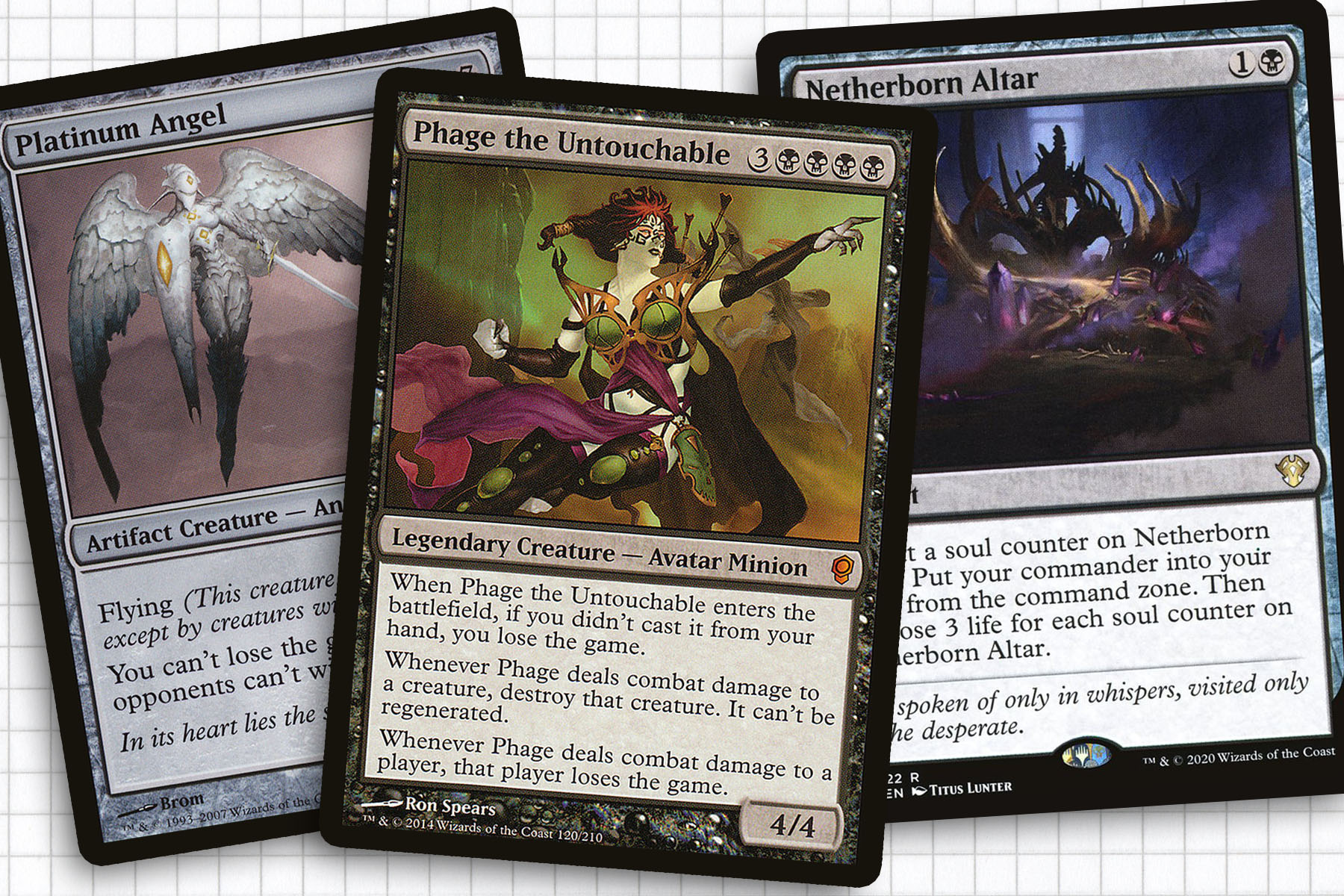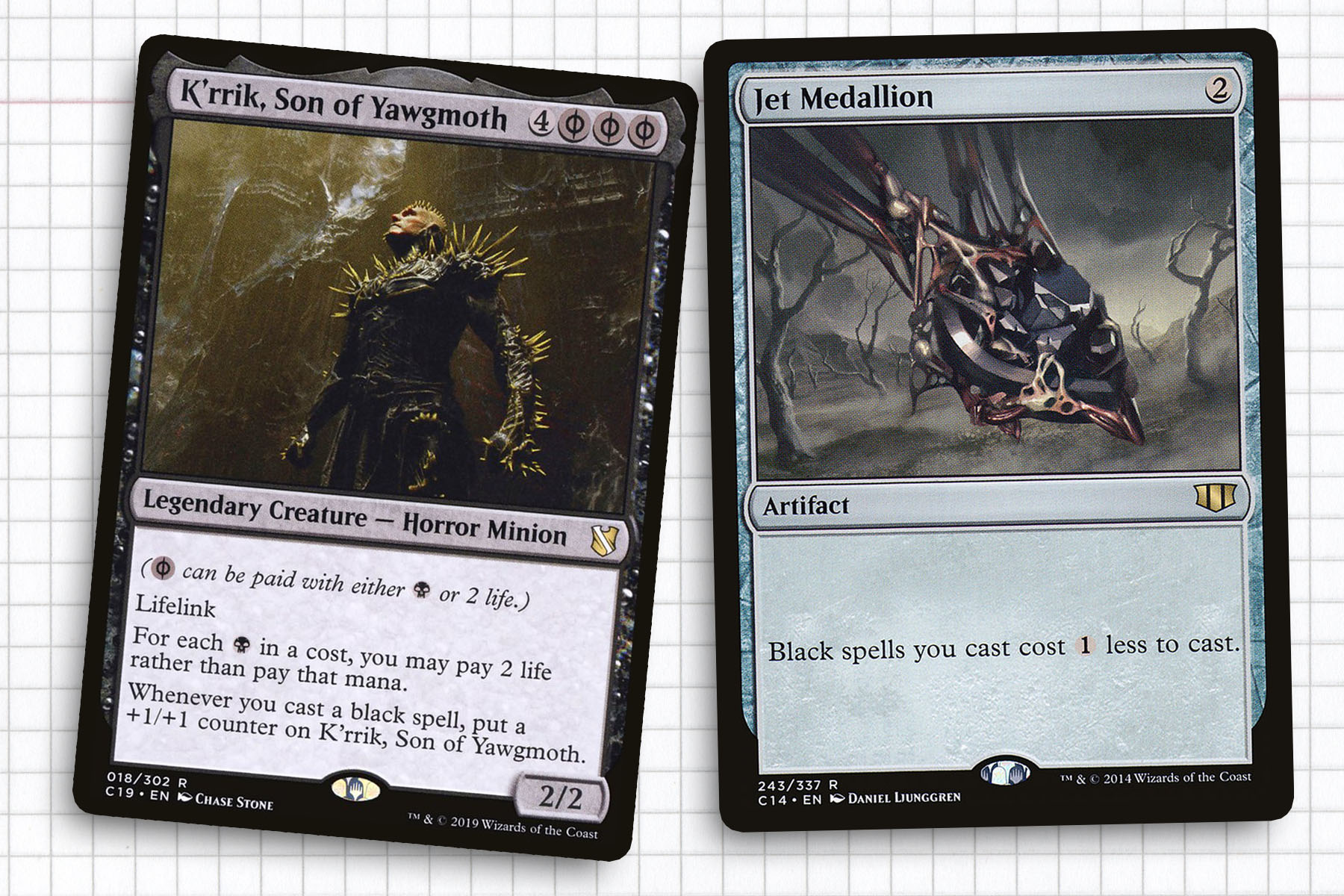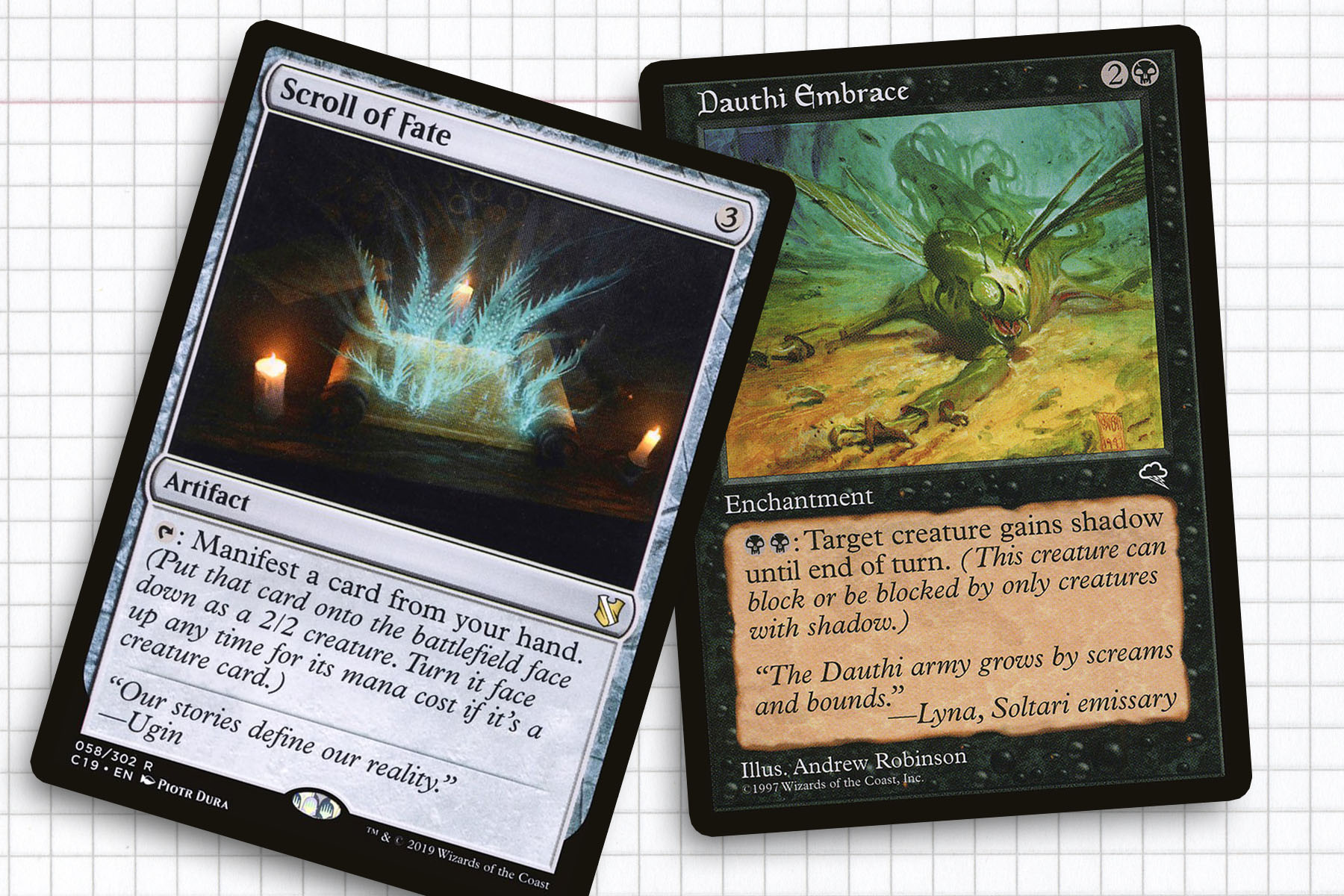Hello and welcome to part two in my investigation (read part one) of the Legions duo, Akroma, Angel of Wrath and Phage the Untouchable. For almost as long as I’ve been playing the game, these two legends have been iconic creatures, but Phage holds an especially dear place in my heart. Phage was the first card I ever bought from an online marketplace, in this case off eBay, because I was so infatuated by the card after reading the Onslaught block novels.
At the time, I don’t know that I really understood how the card matched up mechanically with the character from the written page, but the idea of a character who literally could not be touched by another living thing for fear of death was fascinating. I wanted to make my single copy work somehow as a win condition. If memory serves, I tallied up maybe ten defeats in lunch table games. All these years later and I’ve only now gotten around to committing to the deck in Commander, and that really only manifested itself because I wanted to build it in tandem with Akroma.
This week, I would like to highlight some of the fruits of my labor and talk about the powerful elements of the deck—as well as its unfortunately underwhelming aspects.
Commander: Phage the Untouchable
Creatures: Avatar of Woe, Burning-Rune Demon, Cavern Whisperer, Dauthi Trapper, K’rrik, Son of Yawgmoth, Kozilek’s Channeler, Magus of the Coffers, Platinum Angel, Thrull Wizard, Vampire Hexmage, Visara the Dreadful
Artifacts: Chariot of Victory, Hedron Matrix, Inspiring Statuary, Jet Medallion, Lashwrithe, Loxodon Warhammer, Netherborn Altar, Scroll of Fate, Sol Ring, Sundial of the Infinite, Surveyor’s Scope, Swiftfoot Boots, Sword of Vengeance, Sword of the Animist, Tempting Contract, Thran Dynamo, Torpor Orb, Ur-Golem’s Eye, Wayfarer’s Bauble, Whispersilk Cloak
Enchantments: Dauthi Embrace, Dragon Shadow, Endless Whispers, Exquisite Blood, Heartless Summoning, Lich’s Mastery, Polluted Bonds, Strands of Night, The Eldest Reborn
Planeswalkers: Ob Nixilis Reignited
Instants: Blood Curdle, Cast Down, Consume the Meek, Poison the Cup, Scour from Existence, Stinging Study, Succumb to Temptation, Sudden Spoiling, Tragic Slip, Village Rites, Withering Boon
Sorceries: Beacon of Unrest, Beseech the Queen, Disturbed Burial, Exsanguinate, Feed the Swarm, Fortuitous Find, Mutilate, Read the Bones, Sign in Blood, Yawgmoth’s Vile Offering
Lands: 23 Swamp, Blast Zone, Bojuka Bog, Cathedral of War, Command Beacon, Drownyard Temple, Geier Reach Sanitarium, Ghost Quarter, Guildless Commons, Mikokoro, Center of the Sea, Mirrorpool, Mortuary Mire, Myriad Landscape, Nykthos, Shrine to Nyx, Rogue’s Passage

Phage Starter Kit
In many ways, Phage needs no introduction. She is a unique general that, even two decades in, still holds a place in the minds of Magic players new and old. Even if you’ve never played against the card, you probably know in general terms what she does.
Admittedly, I’m not sure how this deck got along without our contemporary tools. I remember the deck existing circa 2013, but besides using Platinum Angel or Torpor Orb, I can only imagine that people were using mono black counter magic and then returning her to their hand with some kind of Raise Dead. We are lucky to have the tools we do now, because I don’t know that there was much of an efficient way to play her otherwise.
Unfortunately, Phage’s unique structure does result in a pretty standard package of cards that need to be in the deck to make her a possible general to cast. I don’t love it when a deck comes with a handful of staple cards, but for the ability to play with the one-hit knock out of Phage, I will gladly accept that it needs to be some form a two-card combo to set up.
Over the course of Magic’s history, Sundial of the Infinite, Torpor Orb, Lich’s Mastery, and Platinum Angel all come into this deck’s sights through Standard releases. Perhaps unsurprisingly, the Commander products have proven to be a wonderful place for Wizards to print niche roleplayers for this deck. Command Beacon and Netherborn Altar were probably designed to fit the niche situations where a general may be far too expensive from commander tax, but by happenstance, Phage benefits too. This brings the total amount of cards in this package up to six, enough to make the deck pretty consistent.
The great thing about most of these cards is that they can mess with a table that is not prepared for them. Yes, you are signaling that you are going to play Torpor Orb, but decks are not generally constructed in such a way to combat a Phage deck that they may never face. Defanging Craterhoof Behemoth or Grave Titan certainly has value, and some decks are not going to be able to answer Lich’s Mastery fast enough to avoid losing the game themselves.

Bringing Voltron to Black
While we are playing many ways to get around Phage’s drawback, we must also obtain the mana required to cast our general. Once again I want to highlight the power of Inspiring Statuary; it is an overlooked gem that I recall taking note of when it was originally printed five years ago, yet I failed to put it through its paces enough to see the value it has. In the right deck, it takes higher cost generals like Phage—or last week’s general, Akroma—and makes them legitimate contenders for Commander again.
When it comes to additional ramp, the mind set is that the sooner we can play our general, the more likely we can remove our opponents from the game. This deck uses staple cards Jet Medallion and Thran Dynamo, but this also seemed like an appropriate place to use Kozilek’s Channeler and Ur-Golem’s Eye. At this point, Cabal Coffers is still too rich for me, but Magus of the Coffers is a fine substitute and gets the job done.
And lastly, we have K’rrik, Son of Yawgmoth, who wildly swings games and highlights the danger black poses when it is willing to give every resource to win. I have long understood the power of K’rrik, but I don’t know that I was quite prepared for how quickly he invalidates the rest of my ramp package. Because he is able to come down on turn four, he allows us to cast Phage on the next turn and hopefully equip Swiftfoot Boots to swing in at an opponent. Even if that is not the case, we can sidestep so much mana while casting spells like Consume the Meek or activating Dauthi Embrace, that he can often run the table by himself, making him a suitable finisher when using the tools we were already using to force a win with Phage.

Combat Tricks
Now that we’ve covered a lot of the heavy lifting and can successfully cast our general, we are going to want to have a few plans in place to deliver our single blow to each opponent. As a card-carrying Commander Hipster, you know I had to dig through my collection for copies of Dauthi Embrace, Dauthi Trapper, and Dragon Shadow, just to make Phage as scary as possible. Fear does not have the same value as shadow, obviously, but it was retro enough at this point that it snuck in due to nostalgia.
In practice, being evasive was not consistent enough. What I felt the deck really needed was trample and more importantly, first strike: enter Chariot of Victory and Sword of Vengeance. With these two, it became reasonable that we would not lose out on a chance to attack due to a bulky blocker. This would allow Phage to deal the required combat damage to fell a creature before they had the chance to deal any damage back. The important thing to keep in mind is that Phage’s second ability is not the same as deathtouch, meaning that she doesn’t benefit from trample in the same ways. That said, Loxodon Warhammer is still one of my favorite equipment and will be useful for ensuring that some amount of damage reaches our opponent, maybe in combination with Hedron Matrix.
Finally, we have newcomer Scroll of Fate. The initial inclusion in the deck came from a brief misremembering of just how deadly Phage is. Scroll of Fates can’t manifest Phage from the command zone, and if Phage is in my hand, I shouldn’t be worried about her causing me to lose the game. In testing the deck, the Scroll proved itself enough to have other uses outside of protecting me from Phage. It creates this fun guessing game: which of the manifested cards is our deadly general. On top of that, our deck runs a little creature light, with some cards that may be dead in certain situations, like Dragon Shadow or Jet Medallion. Overall, I’m rather pleased with the card and certainly want to use it more often.
Closing Thoughts
While not exclusively built for the purpose, this deck was finalized with the previous article’s deck in mind, in an effort to develop the decks towards an equal power level. I don’t know if I have entirely reached that goal, but it did help to gauge if the decks were performing as intended. Whereas Akroma came together quickly, Phage has proven to have more growing pains. If we can’t ramp and find a way to turn off her enter-the-battlefield ability, a match proves to be no-contest for Akroma to easily win.
In the twenty or so games I have played with the two of them being piloted against a random assortment of other decks I have laying around, Phage has only stumbled in about four games, which resulted in the deck turning into either Visara the Dreadful or K’rrik, Son of Yawgmoth Voltron. This leaves me with a lot of hope for the possible future of this deck, especially if I start optimizing with Demonic Tutor or Diabolic Intent for the aforementioned Phage Package.
Reflecting back, I am disappointed that we have yet to see a new version of Phage. I find her to be an iconic character, worth iterating on, yet it hasn’t happened in the last twenty years. At the same time, I understand that she is built in such a way that is hard to tweak into something that is the same but different. At this point I’m happy to see the Wizards has intentionally or not given us tools that make unconventional generals like Phage playable within the format. I look forward to touching back on this deck, once I’ve had the chance to explore her viability in the wild. Thanks for reading.
Ryan Sainio is a Graphic Designer who writes about EDH and the EDH community. He has been playing Magic: the Gathering since 7th Edition in 2002 and values flavorful and fun gameplay over competitively optimized decks.

